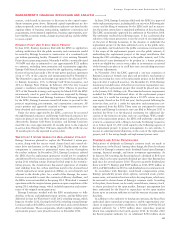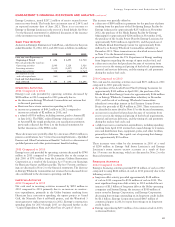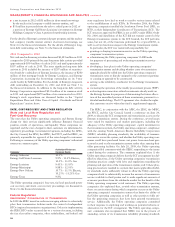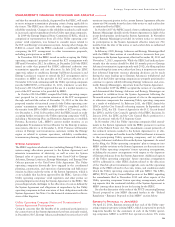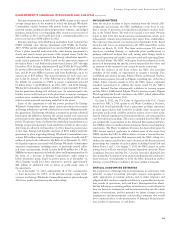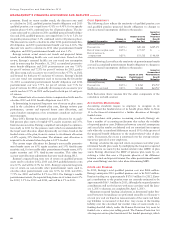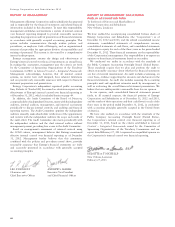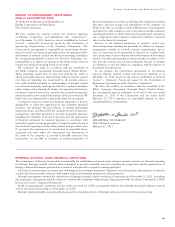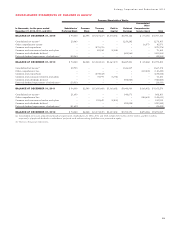Entergy 2012 Annual Report Download - page 45
Download and view the complete annual report
Please find page 45 of the 2012 Entergy annual report below. You can navigate through the pages in the report by either clicking on the pages listed below, or by using the keyword search tool below to find specific information within the annual report.Entergy Corporation and Subsidiaries 2012
MANAGEMENT’S FINANCIAL DISCUSSION AND ANALYSIS continued
Entergy estimates that a positive $10 per MWh change in the annual
average energy price in the markets in which the Entergy Wholesale
Commodities nuclear business sells power, based on the respective
year-end market conditions, planned generation volumes, and hedged
positions, would have a corresponding effect on pre-tax net income of
$125 million in 2013 and would have had a corresponding effect on
pre-tax net income of $48 million in 2012.
Entergy’s purchase of the FitzPatrick and Indian Point 3 plants from
NYPA included value sharing agreements with NYPA. In October
2007, NYPA and the subsidiaries that own the FitzPatrick and Indian
Point 3 plants amended and restated the value sharing agreements to
clarify and amend certain provisions of the original terms. Under the
amended value sharing agreements, the Entergy subsidiaries agreed to
make annual payments to NYPA based on the generation output of
the Indian Point 3 and FitzPatrick plants from January 2007 through
December 2014. Entergy subsidiaries will pay NYPA $6.59 per MWh
for power sold from Indian Point 3, up to an annual cap of $48 mil-
lion, and $3.91 per MWh for power sold from FitzPatrick, up to an
annual cap of $24 million. The annual payment for each year’s out-
put is due by January 15 of the following year. Entergy will record
the liability for payments to NYPA as power is generated and sold
by Indian Point 3 and FitzPatrick. In 2012, 2011, and 2010, Entergy
Wholesale Commodities recorded a liability of approximately $72 mil-
lion for generation during each of those years. An amount equal to the
liability was recorded each year to the plant asset account as contingent
purchase price consideration for the plants. This amount will be depre-
ciated over the expected remaining useful life of the plants.
Some of the agreements to sell the power produced by Entergy
Wholesale Commodities’ power plants contain provisions that require
an Entergy subsidiary to provide collateral to secure its obligations under
the agreements. The Entergy subsidiary is required to provide collateral
based upon the difference between the current market and contracted
power prices in the regions where Entergy Wholesale Commodities sells
power. The primary form of collateral to satisfy these requirements is an
Entergy Corporation guaranty. Cash and letters of credit are also accept-
able forms of collateral. At December 31, 2012, based on power prices
at that time, Entergy had liquidity exposure of $203 million under the
guarantees in place supporting Entergy Wholesale Commodities trans-
actions, $20 million of guarantees that support letters of credit, and $7
million of posted cash collateral to the ISOs. As of December 31, 2012,
the liquidity exposure associated with Entergy Wholesale Commodities
assurance requirements, including return of previously posted collat-
eral from counterparties, would increase by $106 million for a $1 per
MMBtu increase in gas prices in both the short-and long-term markets. In
the event of a decrease in Entergy Corporation’s credit rating to
below investment grade, based on power prices as of December 31,
2012, Entergy would have been required to provide approximately
$48 million of additional cash or letters of credit under some of
the agreements.
As of December 31, 2012, substantially all of the counterparties
or their guarantors for 100% of the planned energy output under
contract for Entergy Wholesale Commodities nuclear plants through
2016 have public investment grade credit ratings.
NUCLEAR MATTERS
After the nuclear incident in Japan resulting from the March 2011
earthquake and tsunami, the NRC established a task force to con-
duct a review of processes and regulations relating to nuclear facili-
ties in the United States. The task force issued a near-term (90-day)
report in July 2011 that made initial recommendations, which were
subsequently refined and prioritized after input from stakeholders.
The task force then issued a second report in September 2011. Based
upon the task force’s recommendations, the NRC issued three orders
effective on March 12, 2012. The three orders require U.S. nuclear
operators, including Entergy, to undertake plant modifications or
perform additional analyses that will, among other things, result in
increased operating and capital costs associated with operating Enter-
gy’s nuclear plants. The NRC, with input from the industry, is in the
process of determining the specific actions required by the orders and
an estimate of the increased costs cannot be made at this time.
With the issuance of the three orders, the NRC also provided
members of the public an opportunity to request a hearing. Two
established anti-nuclear groups, Pilgrim Watch and Beyond Nuclear,
filed hearing requests, focused on Pilgrim, regarding two of the three
orders. These requests sought to have the NRC impose expanded
remedial requirements to address the issues raised by the NRC’s
orders. Beyond Nuclear subsequently withdrew its hearing request
and the NRC’s ASLB denied Pilgrim Watch’s hearing request. Pilgrim
Watch appealed the Board’s decision to the NRC, which affirmed the
Board’s decision in January 2013.
On June 8, 2012, the U.S. Court of Appeals for the D.C. Circuit
vacated the NRC’s 2010 update to its Waste Confidence Decision,
which had found generically that a permanent geologic repository
to store spent nuclear fuel would be available when necessary and
that spent nuclear fuel could be stored at nuclear reactor sites in the
interim without significant environmental effects, and remanded the
case for further proceedings. The court concluded that the NRC had
not satisfied the requirements of the National Environmental Policy
Act (NEPA) when it considered environmental effects in reaching these
conclusions. The Waste Confidence Decision has been relied upon by
NRC license renewal applicants to address some of the issues that
NEPA requires the NRC to address before it issues a renewed license.
Certain nuclear opponents filed requests with the NRC asking it to
address the issues raised by the court’s decision in the license renewal
proceedings for a number of nuclear plants including Grand Gulf and
Indian Point 2 and 3. On August 7, 2012 the NRC issued an order
stating that it will not issue final licenses dependent upon the Waste
Confidence Decision until the D.C. Circuit’s remand is addressed, but
also stating that licensing reviews and proceedings should continue to
move forward. On September 6, 2012 the NRC directed its staff to
develop a revised Waste Confidence Decision within 24 months.
CRITICAL ACCOUNTING ESTIMATES
The preparation of Entergy’s financial statements in conformity with
generally accepted accounting principles requires management to
apply appropriate accounting policies and to make estimates and
judgments that can have a significant effect on reported financial posi-
tion, results of operations, and cash flows. Management has identi-
fied the following accounting policies and estimates as critical because
they are based on assumptions and measurements that involve a high
degree of uncertainty, and the potential for future changes in these
assumptions and measurements could produce estimates that would
have a material effect on the presentation of Entergy’s financial posi-
tion, results of operations, or cash flows.
43




